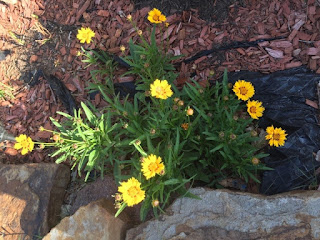... Before the shade-cover disappears... yet in the cool breeze of AM
Wednesday, May 31, 2017
Wednesday, May 17, 2017
Drive-by Nature of the Day
Screeeech....
These pads have grown abt 8-9 inches... so heavy that their own weight breaks the plant! Standing abt 4 ft tall. Oh My! Full sun - hot Oklahoma weather!
Pictured below... this little stumpy cactus was almost tucked back in the shade??? I wonder what it is??
Against this large two story building,.... outstanding 4-5 HUGE prickly pear plants blooming Yellow Flowers ~ Optunia
Optunia... upside-down and pear shaped pad/segments. Gray-light green fleshy pad produce a larger, wonderful yellow all thru flower in the being May/spring time. I'll have to do another DRIVE-BY to see the plant as it is said that the flower turns into red-spiny fruit later in this years season!!!
I kinda wonder if these shoots(in phot below....) are new growth (pads) or if the shoot is a bloomin flower!
I tell you... my God is a wonder.... Such a Happy Gardner - Creator is My God!
I didn't have a knife or gloves.... so I just broke off a few pads! I'll go back and sharpen the removal area.... I'll let the pad sit for a few days... so that the cut joint dries out!
SOIL: I'll need part perlite/part compost via a well-draining plant soil. Fill within abt 2 inch top of pot-- which has to have a drainage hole!!
SOIL: I'll need part perlite/part compost via a well-draining plant soil. Fill within abt 2 inch top of pot-- which has to have a drainage hole!!
4
Set the cactus cutting with the callused edge resting on the soil in the center of the pot. Push one-third to one-half of the cutting into the soil mixture. Tamp the soil down around the base of the cactus until the cutting is able to stand upright on its own.
5
Water the planted cutting using a watering can until the soil is evenly moist. Place the pot in a warm room -- 60 degrees Fahrenheit or warmer -- in filtered sunlight. Water the cactus when the top inch of soil begins to dry out.
6
Decrease supplemental watering to 1/4 inch of water applied every seven days once the cactus becomes established and begins to produce new growth. Follow this water regimen during the months when nighttime temperatures remain above 60 degrees Fahrenheit. Give the cactus 1/4 inch of water every 14 days when nighttime temperatures drop below 60 degrees Fahrenheit.
7
Move the cactus to full sunlight indoors once it begins producing new growth to begin acclimating it to brighter light. Move the cactus to full sunlight outdoors after two weeks if you eventually plan to plant the cactus outdoors in the ground.
8
Grow the cactus in the container for at least one year. Transplant the cactus plant in the spring once soil temperatures reach 60 degrees Fahrenheit. Plant the cactus in an area that receives full sunlight and contains well-draining soil. Dig a hole equal in depth and twice as wide as the plant's root ball. Place the root ball in the center of the hole. Backfill the hole with soil and tamp it down firmly. Water the cactus immediately after planting.
9
Water the planted cactus once per week when nighttime temperatures are above 60 degrees Fahrenheit. Water the cactus every 14 days when nighttime temperatures drop below 60 degrees Fahrenheit.
Monday, May 15, 2017
Tickseed Plants AKA ....
My perennial -- Coreopsis kôrēˈäpsəs FULL SUN easy to grow!
Really eyecatching... these plants are said to form nice, slow spreading clumps of green, thread-like foliage with profusely blooming flowers that stand above the foliage on long, wirey stems.
I did plant them next to my cactus garden area, close to the rock border... and they are said to be great for cut flower arrangements.
Really eyecatching... these plants are said to form nice, slow spreading clumps of green, thread-like foliage with profusely blooming flowers that stand above the foliage on long, wirey stems.
YES --- REMOVE SPENT FLOWERS TO ENSURE CONTINUED BLOOMS!!!
This year's upstart... May 15-2017 I kinda want to compare growth pattern since '2016
I did plant them next to my cactus garden area, close to the rock border... and they are said to be great for cut flower arrangements.
At present... I only cut a few roses and my early blooming peonies to place on the coffee table.
Back to the TICKSEED..... further classified as a "grandiflora... hardy in zones 4-9!!! That's Oklahoma weather summer and winter.
Pictured above May 23,2016) I planted same tickweed last year --kinda lost the name tag under which I planted them....... then they have returned fairly nice at this early part of spring in my flower bed.
Pictured above May 23,2016) I planted same tickweed last year --kinda lost the name tag under which I planted them....... then they have returned fairly nice at this early part of spring in my flower bed.
So... I run across TICKSEED... pretty striking perennial at a Choctaw Oklahoma "EARL'S" nursery.
they're said to form 0-36 inch clumps that will spread to about 18inches -- having bright yellow daisy-like flowers that abt 2-3 inches in diameter.... on tall stems that bloom all summer... MY TASK HUH>>>> ????
Pretty plant tolerates almost any soil -- via good drainage... preferring rocky, sandy slightly acidic soils pH below 6.8
Seldom need fertilizing -- DEADHEAD spent flowers regularly
Can be sheared back by 1/3 in mid to late summer to promote a fall re-bloom... and to groom the plant!
Propagating Coreopsis Plants and Growing them from SeedDig up and divide your Coreopsis clumps every two to three years in the fall after blooming or in the early spring. This will provide you with additional plants as well as keeping your plants thriving. |
Happy Planting ~
Happy Harvesting !
Bev’s
Garden Journey
Subscribe to:
Posts (Atom)
Moonflowers luvin’em
Early summer blooms. Ooohhh the sweet flowers and fragrance That pulled not he garage… I stepped out to sniff the sweet perfume lingering...
















